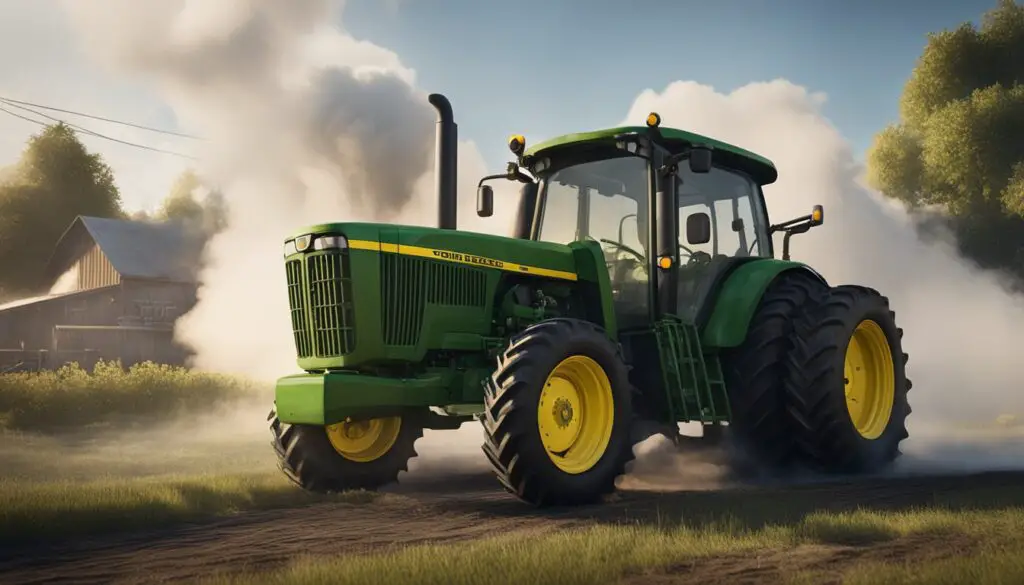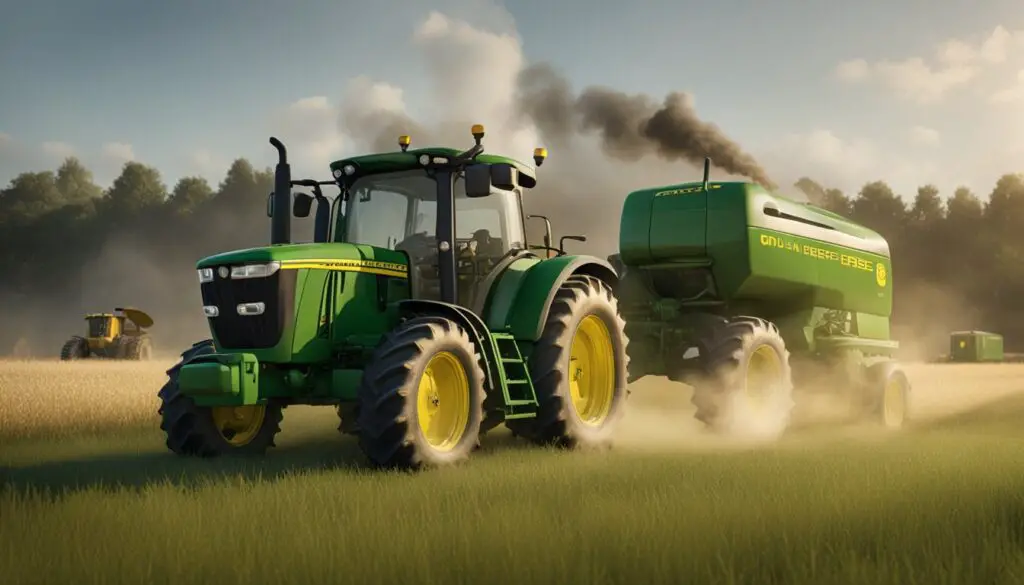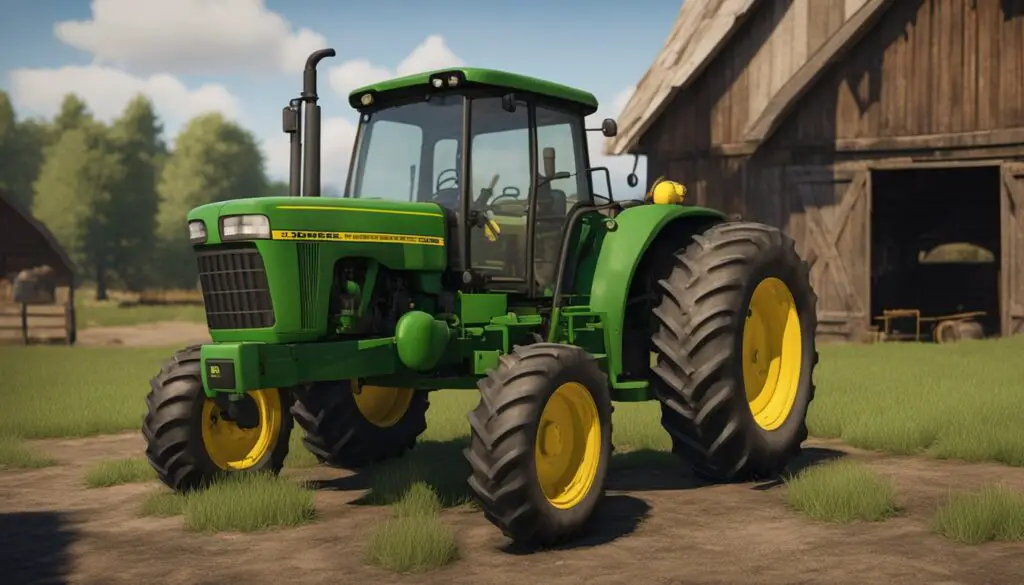The John Deere 3025E compact tractor is a popular choice for small acreage owners and landscapers, prized for its size, power, and versatility. However, like all mechanical equipment, it may encounter problems that can range from minor annoyances to more significant issues that could impact its operation. By being aware of the potential problems and knowing how to address them, you can ensure that your 3025E runs smoothly and continues to be a reliable workhorse for your property.

Common problems with the 3025E include overheating, stalling, issues with the Power Take-Off (PTO), and difficulties starting the tractor. Each of these issues can have a variety of causes, from simple oversight in routine maintenance to more complex mechanical failures. Knowing how to troubleshoot these problems can save you time and money. Additionally, proper maintenance routines such as regular oil changes, filter replacements, and component inspections can prevent many issues before they start, keeping your tractor in top condition.
Key Takeaways
- Knowing common issues with the John Deere 3025E can help you troubleshoot effectively.
- Regular maintenance is crucial for preventing many tractor problems.
- Understanding your tractor’s components is key to long-term care and operation.
Understanding the John Deere 3025E
In diving into the John Deere 3025E, you’ll find it’s a compact utility tractor designed to meet the needs of small farms, landscaping projects, and other residential applications. Let’s explore its design and key operational features to comprehend what makes it a popular choice.
Design and Specifications
Your John Deere 3025E is equipped with a Yanmar 3TNV88F engine, a name that resonates with durability and power. This 3-cylinder diesel engine is capable of delivering 25 horsepower, providing the necessary strength for various tasks. Here’s a quick glance at its core specifications:
- Engine: Yanmar 3TNV88F, 3-cylinder diesel
- Power: 25 HP
- Transmission: Hydrostatic, 2-range
The compact frame of your tractor not only enhances maneuverability but also makes storage more convenient. Its design ensures it can navigate through tighter spaces, which is crucial for small property owners.
Operational Features
One of the standout features of your 3025E is the hydrostatic transmission. This system offers you a smoother ride and easier control, as it eliminates the need for manual gear shifting. It’s designed to be user-friendly, especially for those who may be fairly new to operating tractors. Here are a few operational aspects to consider:
- Ease of Control: Use the twin touch foot pedals to easily increase or decrease speed.
- Maintenance Access: The design facilitates easy access points for regular maintenance tasks to keep your tractor running efficiently.
- PTO: The power take-off (PTO) feature is critical for using various attachments. It makes the tractor versatile for a range of jobs, from mowing to tilling.
By understanding these attributes, you’re better equipped to maximize the potential of your John Deere 3025E tractor. Its design and operational features work together to provide a reliable machine for your property maintenance and farming needs.
Common Issues and Troubleshooting
When you encounter problems with your John Deere 3025E, it’s essential to know the common issues and the steps you can take to troubleshoot them effectively. This section will guide you through identifying and addressing the most prevalent troubles you might face. https://www.youtube.com/embed/vrEjl8kWj-A
Starting Problems
If your John Deere 3025E is having hard starting issues, check the battery and electrical connections first. Corroded terminals or a weak battery can often lead to starting difficulties. Ensure that your battery is fully charged and that all connections are secure and free of corrosion.
Engine Performance
For engine power concerns, such as unwanted knocking or reduced performance, regular maintenance is key. Replace air filters and fuel filters as recommended, and make sure to use clean, high-quality diesel. Additionally, checking the engine oil level and quality can help prevent these issues.
Overheating Issues
Overheating can be caused by several factors, including a clogged radiator or a malfunctioning thermostat. Keep the radiator clear of debris and check coolant levels frequently. If the problem persists, inspect the thermostat and replace it if necessary.
Fuel System Concerns
When facing fuel system problems, such as unusual fuel consumption, inspect for leaks along the fuel lines and ensure the fuel cap is venting properly. Using the correct type and grade of fuel as specified by the manufacturer is also critical to avoid issues.
Hydraulic System Challenges
Lastly, hydraulic system challenges, like sluggish operation or leaks, typically signal the need for fluid level checks and potential line inspections. Make sure the hydraulic fluid is at the appropriate level and look for any signs of leaks, addressing them promptly to maintain performance.
Maintenance and Service

Maintaining your John Deere 3025E tractor is key to ensuring its longevity and performance. Adhering to a regular service schedule and staying on top of fluid and filter management, as well as belt and hose inspections, can help you avoid many common problems.
Regular Service Schedule
Your tractor’s service manual is your go-to resource for creating a maintenance calendar. Regular maintenance typically includes:
- Engine oil and filter changes: Do these every 50 hours or once a season, whichever comes first.
- Transmission fluid check: Inspect every 50 hours and replace fluid as necessary.
- Air filter service: Check the air filter every 25 hours and clean or replace it to prevent airflow issues and engine contamination.
It’s advisable to document each service task to keep track of maintenance history.
Fluid and Filter Management
Fluid and filter maintenance is crucial for your tractor’s health. Use this checklist to manage them effectively:
- Oil levels: Check and maintain proper engine oil levels and change the oil at recommended intervals.
- Fuel filter: Replace the fuel filter every 400 hours to ensure clean fuel delivery.
- Coolant: Monitor coolant levels frequently, and replace according to the service manual’s recommendations to avoid overheating.
Remember, using genuine John Deere filters can enhance your tractor’s performance and longevity.
Belt and Hose Inspections
To prevent unexpected downtime, regularly inspect and maintain belts and hoses:
- Belts: Look for signs of wear like cracks or fraying and replace if needed. Check tension often.
- Hoses: Inspect hoses for leaks or brittle areas. Replace hoses that show any sign of deterioration to prevent leaks and bursts.
Preventive maintenance of belts and hoses can save you from more costly repairs down the line.
Electrical and Battery Concerns

In your John Deere 3025E, electrical and battery issues can manifest through symptoms like difficulty starting and reduced electrical performance. Here’s how you can diagnose and maintain your tractor’s electrical system effectively.
Dead Battery Symptoms
If your tractor won’t start, the lights are dim, or the engine turns over slowly, you may have a dead battery. These are common indicators that the battery lacks the charge to power the electrical system. Check the battery’s voltage with a multimeter—12.6 volts or above is typically considered healthy. Also, visually inspect for any corroded terminals and ensure they are clean and secure for proper operation.
Charging System Checks
To ensure your battery is being properly charged, regular checks are necessary:
- Alternator: Verify that your alternator is functioning correctly, as it’s responsible for charging the battery while the engine runs.
- Voltage: With the engine off, a healthy battery should read about 12.6 volts. With the engine running, the alternator should deliver between 13.8 and 14.2 volts.
- Belts: Inspect the alternator belt for any signs of wear or damage, as a faulty belt can lead to charging issues.
| Condition | Engine Off Voltage | Engine Running Voltage |
|---|---|---|
| Healthy Battery | ~12.6V | N/A |
| Healthy System | N/A | 13.8V – 14.2V |
Electrical Connection Maintenance
Regular maintenance of your John Deere 3025E’s electrical connections can prevent problems before they occur. Follow these steps:
- Inspect and clean all electrical connections, including fuses, to ensure they’re tight and free from corrosion.
- Check the wiring for any signs of damage, such as damaged wires or insulation wear, which could cause shorts or disconnections in the electrical system.
- Finally, ensure the starter motor is receiving sufficient power and is operating correctly, as a faulty starter can mimic a dead battery scenario.
Remember, proper and regular checks can keep your tractor’s electrical system reliable and reduce unexpected downtime.
Specific Component Issues

When maintaining your John Deere 3025E, paying close attention to specific component issues is crucial for optimal performance and longevity. Let’s delve into some common concerns you might encounter.
Oil and Coolant Levels
Checking your oil and coolant levels is essential. A low oil level can lead to increased friction and wear on engine components. Ensure the oil filter is also inspected and replaced as needed to maintain proper oil cleanliness. Similarly, a correct coolant level is key to preventing your tractor from overheating, which could cause major engine damage.
Fuel Injection Components
Your tractor’s performance is largely dependent on its fuel injection components. Dirty fuel injectors can restrict fuel flow, leading to a decrease in power and efficiency. Symptoms like reduced performance and difficulty starting could indicate clogged injectors or low fuel situations.
Air and Oil Filtration
Proper air and oil filtration is vital for the health of your engine. A clogged air filter can restrict air flow, significantly diminishing engine efficiency and power. It’s important to regularly check and replace your air filter to avoid issues. Similarly, a well-maintained oil filter is necessary to prevent contaminants from damaging internal engine parts.
PTO and Clutch Pack Conditions
PTO problems and compromised clutch packs can manifest through difficulty in engaging or disengaging the PTO, or unexpected loss of power to PTO-driven implements. Regularly inspecting the clutch pack can prevent these issues and ensure that your PTO operates smoothly.
Tips for Prolonged Use and Care

Proper maintenance and care for your John Deere 3025E can significantly reduce the likelihood of operational issues and extend its useful life. Here’s how you can keep your tractor running smoothly.
Operational Best Practices
- Routine Check-Ups: Before and after use, check your tractor for any signs of wear or damage. Make sure to fill up all fluids to their recommended levels, and inspect belts and hoses for integrity.
- Seasonal Maintenance: Adjust your maintenance schedule based on seasonal conditions. For example, ensure to use the correct oil viscosity during colder months to keep the engine running efficiently.
Avoiding Common Mistakes
- Avoid Overworking: Pushing your tractor beyond its limits can shorten its lifespan. Use your John Deere 3025E as intended and avoid prolonged use at maximum capacity.
- Proper Storage: When not in use, store your tractor in a covered and dry area to prevent rust and decay. Battery maintenance is also crucial; ensure it’s fully charged and disconnected if stored for an extended period.
When to Seek Professional Help
- Unusual Noises or Smoke: If you observe unexpected noises, smoke, or smells during operation, cease use immediately. These are clear signals that professional service may be needed.
- Regular Service Intervals: Beyond DIY care tips, adhere to the service intervals specified by John Deere. Professional servicing ensures that complex systems are properly maintained and can prevent future costly repairs.

fectively.
Frequently Asked Questions
If you’re facing issues with your John Deere 3025E, you’re not alone. Below are common questions and troubleshooting tips for engine, electrical, starting, operational, hydraulic, and transmission troubles you might encounter.
What are common engine issues in the John Deere 3025E?
Your John Deere 3025E may experience power loss or unwanted noise. Regular maintenance is key to preventing such issues, but when they occur, check fuel quality and air filters as they can directly impact engine performance.
How do I troubleshoot electrical problems on the John Deere 3025E?
For electrical issues, check the battery connections for corrosion and ensure the terminals are tight. Look at fuses and wiring for any signs of damage. Consistent battery maintenance can prevent many electrical problems.
What should I do when my John Deere 3025E won’t start?
Make sure your fuel is fresh and there’s enough of it. Then, check the battery charge and the connections. Also, inspect the safety switches. These are often the culprits when your tractor fails to start.
Why does my John Deere 3025E randomly shut off during operation?
Sudden stalling can be caused by overheating or fuel delivery issues. Ensure the cooling system is clean and functioning properly and that the fuel filter isn’t clogged or the fuel lines kinked.
What are typical hydraulic system problems for the John Deere 3025E?
Hydraulic issues may present as slow or jerky operations. Check your hydraulic fluid level and look for leaks. Sometimes air in the system or contaminated fluid can affect the hydraulic performance.
How can transmission issues in a John Deere 3025E be identified and fixed?
Transmission problems might show as difficulty in changing gears or poor response. Ensure the transmission fluid is at the correct level and is not contaminated. For mechanical issues, it’s often best to consult a professional.
Leave a Reply